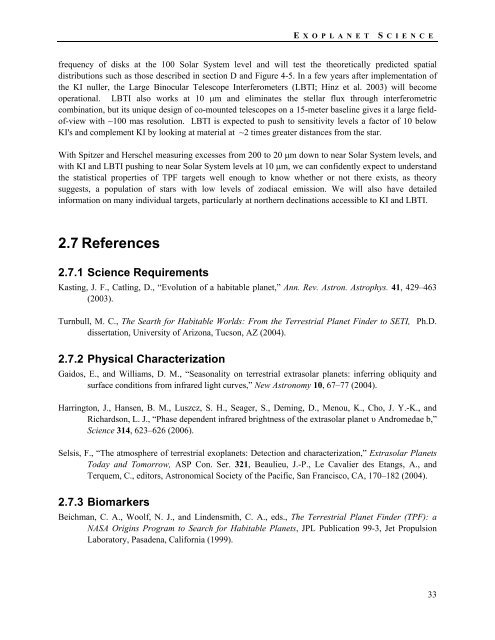TPF-I SWG Report - Exoplanet Exploration Program - NASA
TPF-I SWG Report - Exoplanet Exploration Program - NASA
TPF-I SWG Report - Exoplanet Exploration Program - NASA
Create successful ePaper yourself
Turn your PDF publications into a flip-book with our unique Google optimized e-Paper software.
E X O P L A N E T S CIENCE<br />
frequency of disks at the 100 Solar System level and will test the theoretically predicted spatial<br />
distributions such as those described in section D and Figure 4-5. In a few years after implementation of<br />
the KI nuller, the Large Binocular Telescope Interferometers (LBTI; Hinz et al. 2003) will become<br />
operational. LBTI also works at 10 μm and eliminates the stellar flux through interferometric<br />
combination, but its unique design of co-mounted telescopes on a 15-meter baseline gives it a large fieldof-view<br />
with ~100 mas resolution. LBTI is expected to push to sensitivity levels a factor of 10 below<br />
KI's and complement KI by looking at material at ~2 times greater distances from the star.<br />
With Spitzer and Herschel measuring excesses from 200 to 20 μm down to near Solar System levels, and<br />
with KI and LBTI pushing to near Solar System levels at 10 μm, we can confidently expect to understand<br />
the statistical properties of <strong>TPF</strong> targets well enough to know whether or not there exists, as theory<br />
suggests, a population of stars with low levels of zodiacal emission. We will also have detailed<br />
information on many individual targets, particularly at northern declinations accessible to KI and LBTI.<br />
2.7 References<br />
2.7.1 Science Requirements<br />
Kasting, J. F., Catling, D., “Evolution of a habitable planet,” Ann. Rev. Astron. Astrophys. 41, 429–463<br />
(2003).<br />
Turnbull, M. C., The Searth for Habitable Worlds: From the Terrestrial Planet Finder to SETI, Ph.D.<br />
dissertation, University of Arizona, Tucson, AZ (2004).<br />
2.7.2 Physical Characterization<br />
Gaidos, E., and Williams, D. M., “Seasonality on terrestrial extrasolar planets: inferring obliquity and<br />
surface conditions from infrared light curves,” New Astronomy 10, 67–77 (2004).<br />
Harrington, J., Hansen, B. M., Luszcz, S. H., Seager, S., Deming, D., Menou, K., Cho, J. Y.-K., and<br />
Richardson, L. J., “Phase dependent infrared brightness of the extrasolar planet υ Andromedae b,”<br />
Science 314, 623–626 (2006).<br />
Selsis, F., “The atmosphere of terrestrial exoplanets: Detection and characterization,” Extrasolar Planets<br />
Today and Tomorrow, ASP Con. Ser. 321, Beaulieu, J.-P., Le Cavalier des Etangs, A., and<br />
Terquem, C., editors, Astronomical Society of the Pacific, San Francisco, CA, 170–182 (2004).<br />
2.7.3 Biomarkers<br />
Beichman, C. A., Woolf, N. J., and Lindensmith, C. A., eds., The Terrestrial Planet Finder (<strong>TPF</strong>): a<br />
<strong>NASA</strong> Origins <strong>Program</strong> to Search for Habitable Planets, JPL Publication 99-3, Jet Propulsion<br />
Laboratory, Pasadena, California (1999).<br />
33
















